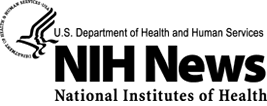Last updated: March 10, 2011
New robot system to test 10,000 chemicals for toxicity

In cooperation with the U.S. Environmental Protection Agency
and the U.S. Food and Drug Administration
National Institute of Environmental Health Sciences (NIEHS)
www.niehs.nih.gov
National Human Genome Research Institute
National Human Genome Research Institute
New robot system to test 10,000 chemicals for toxicity
Bethesda, Md., Thurs., March 10, 2011 — Several federal agencies, including the National Institutes of Health, today unveiled a new high-speed robot screening system that will test 10,000 different chemicals for potential toxicity. The system marks the beginning of a new phase of an ongoing collaboration, referred to as Tox21, that is working to protect human health by improving how chemicals are tested in the United States.
The robot system, which is located at the NIH Chemical Genomics Center (NCGC) in Rockville, Md., was purchased as part of the Tox21 collaboration. Tox21 was established in 2008 between the National Institute of Environmental Health Sciences National Toxicology Program (NTP), the National Human Genome Research Institute (NHGRI), and the U.S. Environmental Protection Agency (EPA), with the addition of the U.S. Food and Drug Administration (FDA) in 2010. Tox21 merges existing agency resources (research, funding, and testing tools) to develop ways to more effectively predict how chemicals will affect human health and the environment.
The 10,000 chemicals screened by the robot system include compounds found in industrial and consumer products, food additives, and drugs. A thorough analysis and prioritization process from more than 200 public databases of chemicals and drugs used in the United States and abroad was conducted to select the initial 10,000 chemicals for testing. Testing results will provide information useful for evaluating if these chemicals have the potential to disrupt human body processes enough to lead to adverse health effects.
"Tox21 has used robots to screen chemicals since 2008, but this new robotic system is dedicated to screening a much larger compound library," said NHGRI Director Eric Green, M.D., Ph.D. The director of the NCGC at NHGRI, Christopher Austin, M.D., added "The Tox21 collaboration will transform our understanding of toxicology with the ability to test in a day what would take one year for a person to do by hand."
"The addition of this new robot system will allow the National Toxicology Program to advance its mission of testing chemicals smarter, better, and faster," said Linda Birnbaum, Ph.D., NIEHS and NTP director. "We will be able to more quickly provide information about potentially dangerous substances to health and regulatory decision makers, and others, so they can make informed decisions to protect public health."
Tox21 has already screened more than 2,500 chemicals for potential toxicity, using robots and other innovative chemical screening technologies.
"Understanding the molecular basis of hazard is fundamental to the protection of human health and the environment," said Paul Anastas, Ph.D., assistant administrator of the EPA Office of Research and Development. "Tox21 allows us to obtain deeper understanding and more powerful insights, faster than ever before."
"This partnership builds upon FDA's commitment to developing new methods to evaluate the toxicity of the substances that we regulate," said Janet Woodcock, M.D., director of the FDA Center for Drug Evaluation and Research.
For B-Roll clips from the NCGC facility and a time lapse sequence of the robot being built, see Tox21 Collaboration: Robot B-Roll.
For more information about Tox 21, visit High Throughput Screening Initiative
The NIEHS supports research to understand the effects of the environment on human health and is part of NIH. For more information on environmental health topics, visit www.niehs.nih.gov. Subscribe to one or more of the NIEHS news lists (www.niehs.nih.gov/news/releases/newslist/index.cfm) to stay current on NIEHS news, press releases, grant opportunities, training, events, and publications.
The NTP is an interagency program established in 1978. The program was created as a cooperative effort to coordinate toxicology testing programs within the federal government, strengthen the science base in toxicology, develop and validate improved testing methods, and provide information about potentially toxic chemicals to health, regulatory, and research agencies, scientific and medical communities, and the public. The NTP is headquartered at the NIEHS. For more information about the NTP, visit http://ntp.niehs.nih.gov.
The National Human Genome Research Institute is part of the National Institutes of Health. For more about NHGRI, visit www.genome.gov.
The National Institutes of Health (NIH) - The Nation's Medical Research Agency - includes 27 Institutes and Centers and is a component of the U.S. Department of Health and Human Services. It is the primary federal agency for conducting and supporting basic, clinical and translational medical research, and it investigates the causes, treatments, and cures for both common and rare diseases. For more information about NIH and its programs, visit www.nih.gov.
Contacts
Robin Mackar, NIEHS919-541-0073
rmackar@niehs.nih.gov
Geoff Spencer, NHGRI
301-402-0911
spencerg@mail.nih.gov
Posted: March 10, 2011
